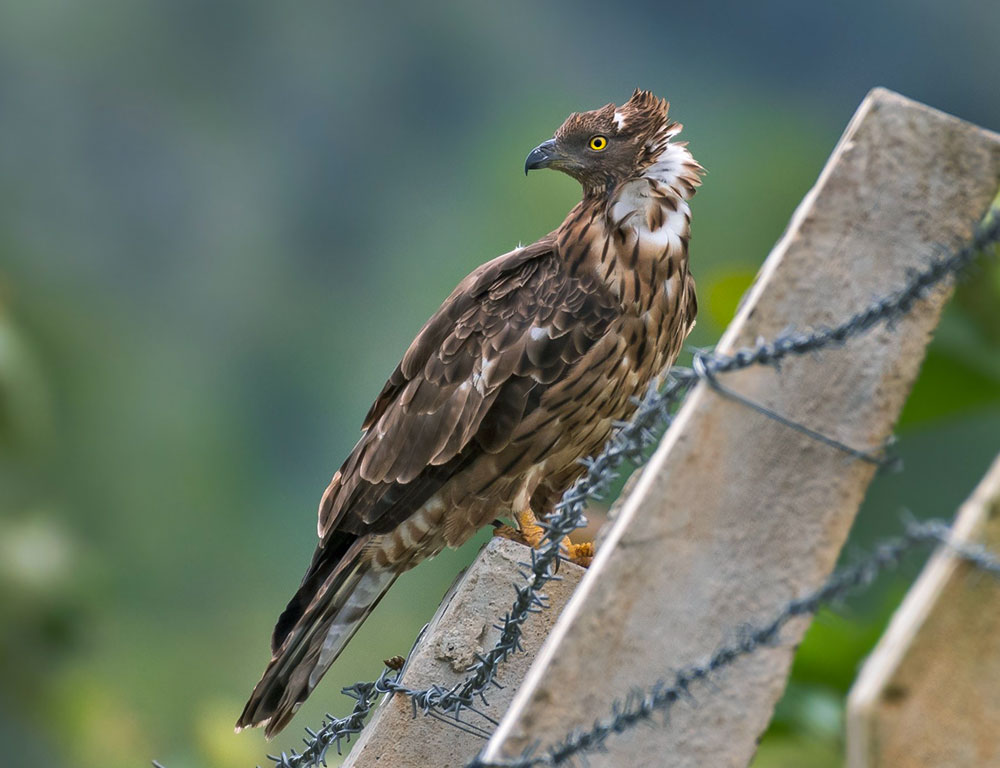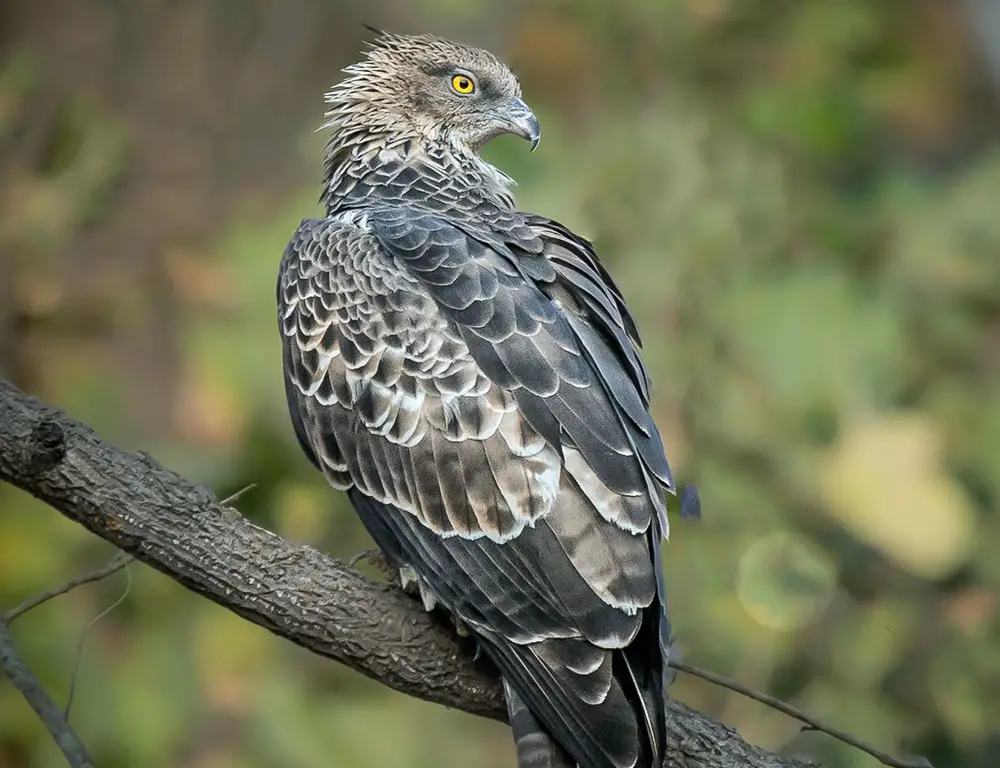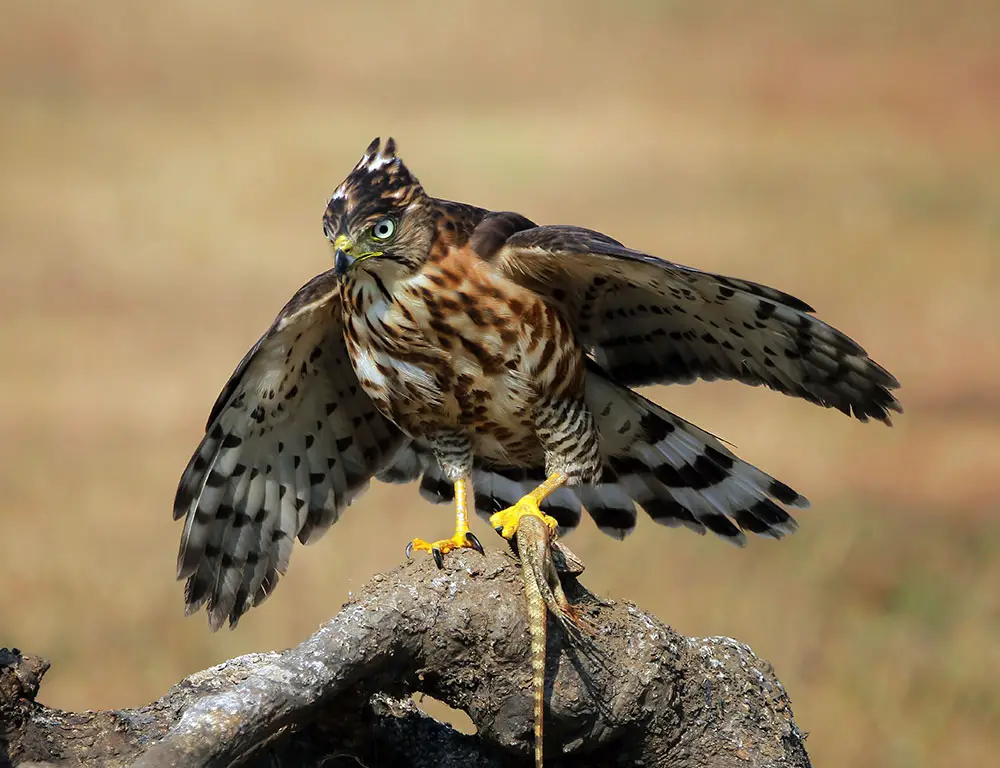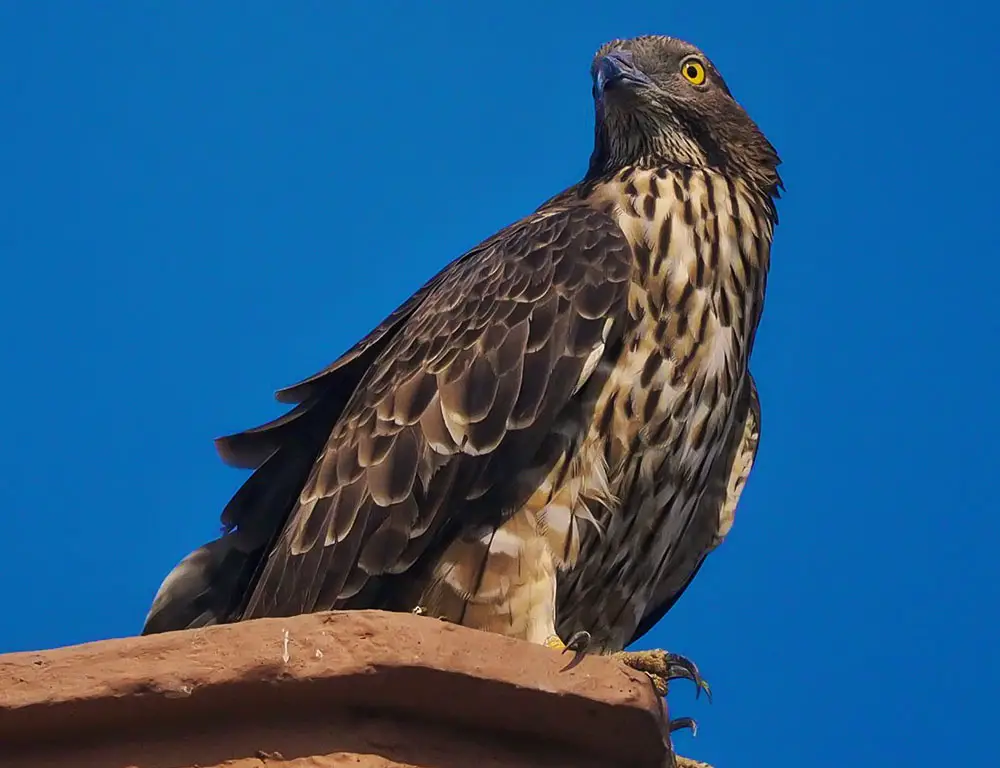The Crested Honey Buzzard, a majestic member of the Accipitridae family, captivates birdwatchers with its splendor and intrigue.
It journeys from Asia to tropical Africa as a migratory species, showcasing impressive endurance and navigational skills.
Yet, what truly sets this avian wonder apart is its unique diet – primarily feasting on larvae from beehives. Beyond its striking appearance, the Crested Honey Buzzard plays a vital role in our ecosystem by controlling insect populations, mainly targeting bee and wasp nests.
Soaring through the sky, these elegant creatures grace us with their beauty and contribute significantly to maintaining ecological balance.
Physical Characteristics of the Crested Honey Buzzard

The Crested Honey Buzzard, a lesser-known member of the raptor family, possesses a distinctive set of physical characteristics that distinguish it from other birds of prey.
Here’s a summary:
Body Shape
It features a long and slender body, reminiscent of a goshawk rather than the bulkier build typically associated with predators. Its body length ranges from 20 to 24 inches, accompanied by an impressive wingspan of up to 52 inches.
Plumage
The bird’s predominantly brown plumage is excellent camouflage against tree bark, aiding it in stealth while hunting. Males tend to be darker in color compared to females. Notably, its tail feathers exhibit distinct bars of white and dark brown.
Crest
A defining feature of the Crested Honey Buzzard is the crest atop its head. Short, pointed feathers protrude from the back of its crown, which can be raised or lowered at will, adding to its allure.
Eyes and Beak
Framed by yellow ceres, the bird’s deep brown irises provide a striking contrast. Its hooked beak is ideally suited for tearing into hives and consuming honeycomb, which explains the “honey” in its name.
Feet
The bird’s feet are specialized for its hunting and feeding habits. It possesses solid talons for gripping branches and flat toes. It is adept at crushing bee hives, showcasing remarkable precision and adaptability to dietary needs.
Habitat and Distribution of the Crested Honey Buzzard

The Crested Honey Buzzard, scientifically known as Pernis ptilorhynchus, is a bird species with a diverse habitat and distribution across Asia, particularly during its breeding season.
Here’s a comprehensive overview of its habitat preferences and distribution patterns:
Habitat Preference
- Broadleaf Forests: These birds primarily inhabit broadleaf forests, especially those with abundant old trees, which offer ample nesting sites.
- Other Environments: While they prefer forests, Crested Honey Buzzards are adaptable and can be found in plantations, parklands, and even suburban gardens, providing an adequate food supply.
Distribution
- Breeding Season: During the breeding season, which typically occurs in the warmer months, Crested Honey Buzzards have a widespread presence across various countries in Asia, including Japan, China (extending down to Vietnam), and over towards India.
- Winter Migration: When temperatures drop significantly in their breeding areas, these birds migrate southwards to seek warmer climates. They are known to winter in regions such as Indonesia, the Philippines, Malaysia, and Australia.
- Migratory Pattern: The migration pattern typically involves movements from breeding grounds to wintering grounds and vice versa, with specific stopover locations in between.
- Year-round Residents: Interestingly, some populations have opted to remain in certain areas year-round, such as Taiwan and Hong Kong, indicating their ability to tolerate a range of climates.
Occasional Sightings
While the Crested Honey Buzzard is primarily found in Asia, occasional sightings outside its usual range have been reported, particularly in Europe.
These sightings are often attributed to extreme weather conditions or changes in food availability, prompting these birds to travel remarkable distances.
Dietary Connection
The bird’s habitat choice is closely linked to its diet, primarily of larvae from bees’ and wasps’ nests.
This dietary preference is reflected in its common name, the “Honey” Buzzard, highlighting its unique adaptation to foraging habits that involve accessing potentially dangerous prey.
Diet and Feeding Behavior of the Crested Honey Buzzard

The Crested Honey Buzzard exhibits a fascinating array of dietary preferences and feeding behaviors, showcasing its adaptability and unique strategies for survival:
Primary Diet
The bird is primarily an insectivore, with a significant portion of its diet consisting of insects, notably wasps and bees.
Raiding Nests
One distinctive behavior is its boldness in raiding nests of wasps and bees. Despite the potential risks of stinging insects, Crested Honey Buzzards dive fearlessly into hives to secure their meals.
Their immunity to venomous stings further facilitates this daring feeding strategy.
Diverse Diet
While insects form the cornerstone of their diet, Crested Honey Buzzards consume various other prey items, including small mammals, reptiles, and birds. This diverse diet enables them to thrive in various environments, from dense forests to open savannahs.
Scavenging
In addition to hunting live prey, these birds also display scavenging behavior. They opportunistically feed on roadkill and leftovers from other animals’ meals, embodying a “waste not, want not” approach towards food resources.
Insights into Nature
Studying the Crested Honey Buzzard provides valuable insights into the diversity and adaptability of natural ecosystems.
From their specialized hunting techniques to their ability to exploit various food sources, these birds offer intriguing lessons in survival and ecological resilience.
Conservation Status of the Crested Honey Buzzard

The conservation status of the Crested Honey Buzzard, currently listed as “Least Concern” by the International Union for Conservation of Nature (IUCN), offers a reassuring perspective on its global survival.
However, regional challenges pose significant threats to specific populations, underscoring the need for continued vigilance and conservation efforts. Here’s a closer examination:
Global Status
The overall classification of “Least Concern” indicates that, on a global scale, the Crested Honey Buzzard is not currently facing imminent threats to its survival.
Regional Threats
Despite its global status, localized threats, particularly habitat loss and degradation, endanger populations in specific areas. For instance, deforestation activities in regions like Japan, where these birds breed extensively, have led to a notable decrease in population numbers.
Population Trend Data
A closer look at population trend data reveals concerning patterns. While the population was stable in 2000, there has been a consistent decline since 2010, indicating a worrisome trend that demands attention.
Importance of Conservation
Conservation efforts are crucial for mitigating immediate threats and ensuring the species’ long-term survival.
Local initiatives to preserve habitats and address specific threats are essential for maintaining healthy populations of Crested Honey Buzzards.
Challenges and Solutions
Despite protective legislation in countries such as India and China, effective implementation remains challenging. Enhancing public awareness about the importance of biodiversity and ecosystems can foster more significant support for conservation efforts.
Ongoing Vigilance
While the “Least Concern” designation provides some reassurance, it underscores the need for ongoing vigilance and concerted action to safeguard the future of these remarkable birds.
Conclusion
The Crested Honey Buzzard has captivated with its unique traits, from its specialized adaptations for raiding beehives to its impressive annual migrations.
This bird’s primary diet of bees and wasps showcases its resilience and resourcefulness in facing challenges.
As we marvel at its physical features, like long toes and protective feathering, we’re reminded of nature’s ingenious designs. Yet, amidst our fascination, we’re also prompted to consider its conservation status amidst habitat loss concerns.
Exploring the life of the Crested Honey Buzzard underscores the importance of continued research and conservation efforts to safeguard this remarkable species and the ecosystems it inhabits.